 |
| Two males. |
 |
| Two seconds later. One male and a ripple. |
Nature notes and photos from BC, Canada, mostly in the Lower Fraser Valley, Bella Coola, and Vancouver Island.
 |
| Two males. |
 |
| Two seconds later. One male and a ripple. |
 |
| Two spiders, running. |
 |
| A wolf spider, maybe. The wood grain gives some idea of the scale. A mid-sized spider. |
 |
| Spider hangout, at the tip of the red arrow. |
 |
| Two more mushrooms, grass, 9-lobes, and purple-fringed dead-nettle. |
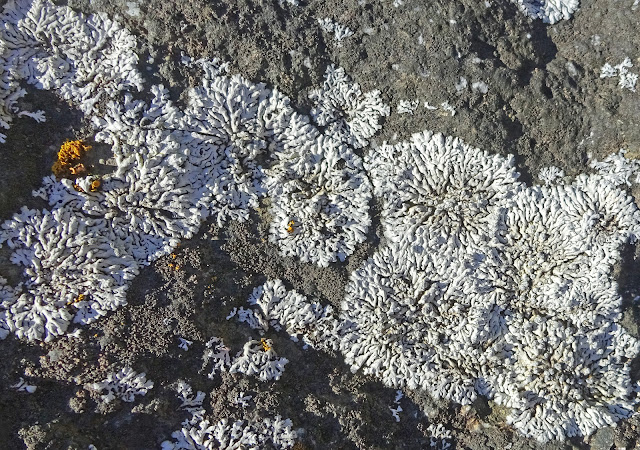 |
| Bull's-eye lichens, Placopsis sp. |
 |
| Zooming in on one of the targets. The roughened, round structures, mostly toward the centre, are reproductive organs. |
 |
| The red arrow points to the lichen. I was following the trail to Ripple Rock, at the narrow point of the channel, but stopped here. |
 |
| Limpet species can sometimes be identified by the shell pattern and shape. Not so easily when they're old, though; the surface gets battered and broken. The limpet inside is fine. |
 |
| Young limpet, wearing a pale checkerboard pattern. Note the off-centre peak. Possibly a shield limpet, Lottia pelta*. And, lower left, an elongated, more delicate limpet. |
 |
| The top limpet, a young'un, is probably the Mask limpet, Tectura persona. In the centre, a baby clam. I don't know what it's doing there. |
 |
| A bashed, cracked,porous limpet shell. The peak is well to one side; the owner may be a slippersnail. |
 |
| Another oldster. The pattern is almost gone, and the peak is off-centre. Another Mask, possibly. |
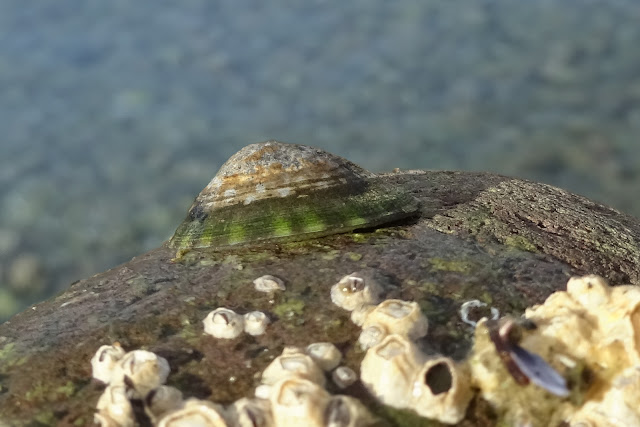 |
| The green colour is painted by algae. There's still a few hints of the original checkerboard pattern. |
 |
| Sea noodles, aka Succulent seaweed, Sarcodiotheca gaudichaudii. |
When fresh the red string seaweed may be used in salads. In the Philippines it is made into a sweet desert. (from Puget Sound Sea Life)
 |
| Red, green, brown. All green shore crabs, Hemigrapsus oregonensis. |
 |
| Shiny, multicoloured polychaete |
Their mouths vary depending on their diet, since the group includes predators, herbivores, filter feeders, scavengers, and parasites. Most have a pair of jaws and a pharynx that can be quickly turned inside out, allowing the worm to grab food and pull it into the mouth. (MESA)
 |
| A Mud nemertean, Paranemertes peregrina, and something green in a long tube. |
On contact with nereid prey, P. peregrina pulls its head back and everts its light-colored proboscis, which wraps around the prey. The prey is soon paralyzed, ... P. peregrina then swallows the nereid. After feeding it follows its own slime trail back to its burrow. It eats about one prey worm per day ... (WallaWalla.edu)
 |
| A typical squirm of green ribbon worms, Emplectonema gracile. And a lone, brown flatworm. |
 |
| Swarming with life. Left to right; barnacle-eating nudibranchs, hermit crabs in periwinkle shells, maybe some snails in their own shells, barnacles, egg mass, Wosnesenski's isopods, "grape" seaweed. |
 |
| Zooming in on the busy end. There are a couple more nudibranchs here, too. Click to see the individual eggs in the egg mass. |
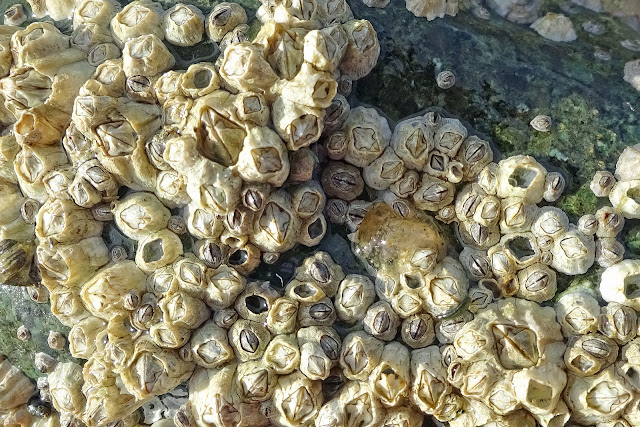 |
| Acorn barnacles, Balanus glandula, and Little brown barnacles, Chthamalus dalli. |
 |
| And here's one of the nudibranchs, Onchidoris bilamellata. |
 |
| This would be a leaf lichen. Shrub lichens have cylindrical stems; this has flattened stems, like skinny leaves. |
 |
| Another skinny leaf lichen. |
 |
| A ruffled leaf, or rag lichen. (Ragbag?) |
 |
| Appressed leaf lichen. |
 |
| A hairy, "beard" lichen, fallen in great clumps from the trees above. |
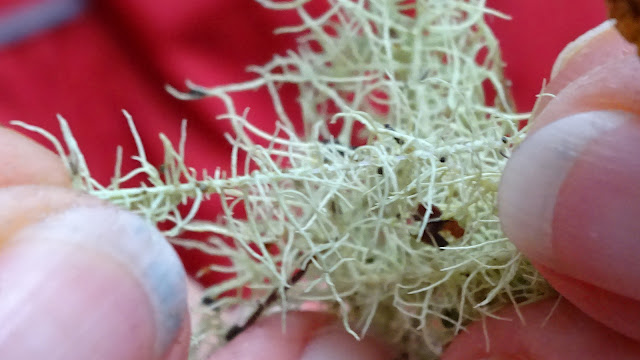 |
| Fuzzy photo through a wet lens. Usnea sp. |
 |
| A bit of everything, all growing together. At least four lichens, yellowish shelf mushrooms with purple borders, two mosses, and salal leaves, on a dead branch. |
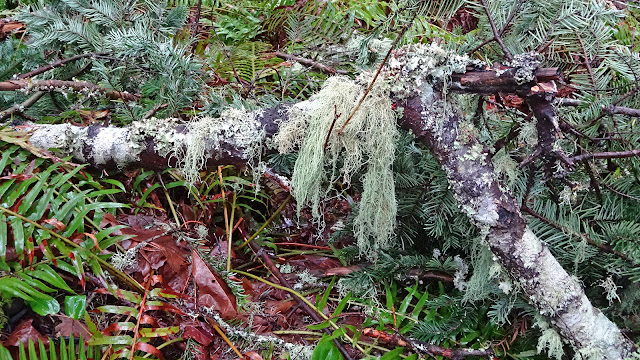 |
| More mixed lichens on an evergreen branch. The recent wet weather brought down many branches from overhead; usually these are out of reach. |
 |
| Black polypores dwarfing the stump they're growing on. |
 |
| Fingertip yellow jelly fungus. (Tremella. See comments.) |
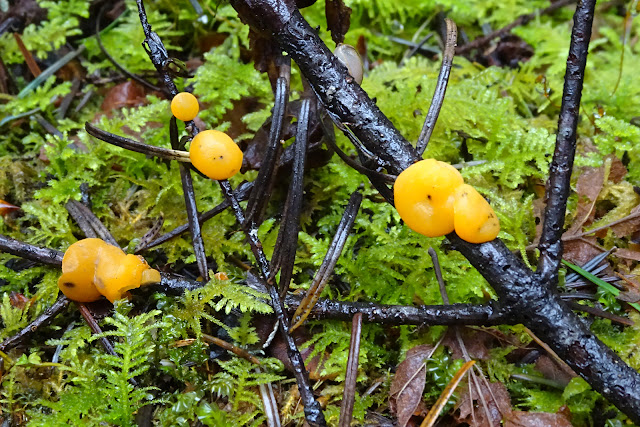 |
| Dead evergreen branch with a bunch of fingertip yellow fungi. |
 |
| More yellow jellies, with a different growth pattern. On old log. (Dacrymyces chrisospermus?) |
 |
| Very yellow jelly. With hungry slugs. |
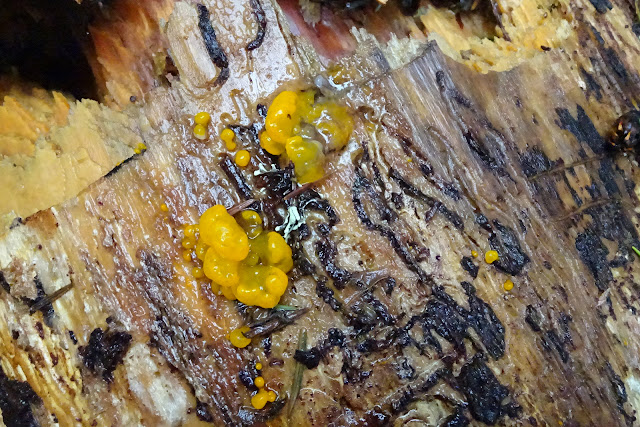 |
| Baby yellow jellies on peeled log, with insect tunnels. |
 |
| "And what is that one?" |
 |
| The green or red capsules are sporophytes, growing spores. |
It's always possible, and very easy, to determine whether you have a moss, liverwort or hornwort if sporophytes are present. Remember that a sporophyte consists of a spore capsule, with or without a supporting stalk or seta.
Are groups of spore capsules held aloft on complex structures?A fuzzy head, like a pussy willow or a grass ear, would be a complex structure. If the "moss" has those, it's a liverwort.
The bryophyte is a liverwort.
If the stem is translucent (and often colourless) the bryophyte in question is almost certainly a liverwort.
If the stalk supporting the capsule is opaque and coloured green, brown or red the bryophyte in question is a moss.
If sporophytes are absent you'll naturally need to look at some gametophyte features, the first step being to see whether you have a thallose or a leafy bryophyte. A thallose bryophyte is either a liverwort or a hornwort. A leafy bryophyte is either a moss or a liverwort.(Hornworts are aquatic; we can ignore them for now.)
The first thing to do is to see whether you have a thallose or a leafy bryophyte. The almost leathery thallus of a robust thallose bryophyte is fairly easy to pick. Similarly, in some leafy species the leaves-on-stems growth habit is very easy to see.For this, with some of the plants, we need a lens; some liverwort thalli look like stems and leaves to the naked eye.
In the great majority of moss species the mature spore capsule opens by means of a well-defined mouth. Remember that a liverwort spore capsule never has a well-defined mouth.To see that, a lens is probably needed. And being there at the right time, when the spores are mature, or already released.
 |
| The moss is green and leafy; even in this photo, the stems are visible as a separate structure from the leaves. The liverwort is one of the leafy ones; the leaves are short and stubby. Luckily, it's red. |
 |
| Frullania nisquallensis, "Hanging millipede liverwort". |
Frullania nisquallensis, commonly known as Hanging millipede liverwort, is a reddish-brown species of liverwort in the Jubulaceae family. It is found in western Washington and British Columbia, including Vancouver Island. The plant grows in mats, sometimes in mats that hang from tree branches (particularly those of alders, or maples), or growing close to the substrate. (Wikipedia) (My emphasis)
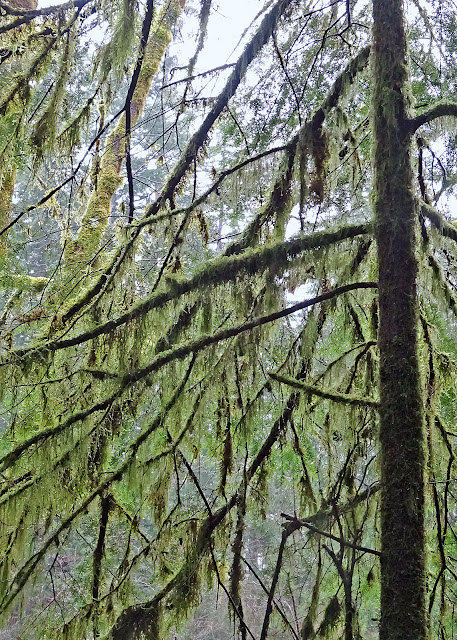 |
| The woods were hairy, dark, and deep. (Sorry, Robert Frost!) |
 |
| And lumpy. |
 |
| A different variety of lumps. With leaf lichen and infant Cladonia in the open spaces. |
 |
| Wet country. Even the sign is wet. |
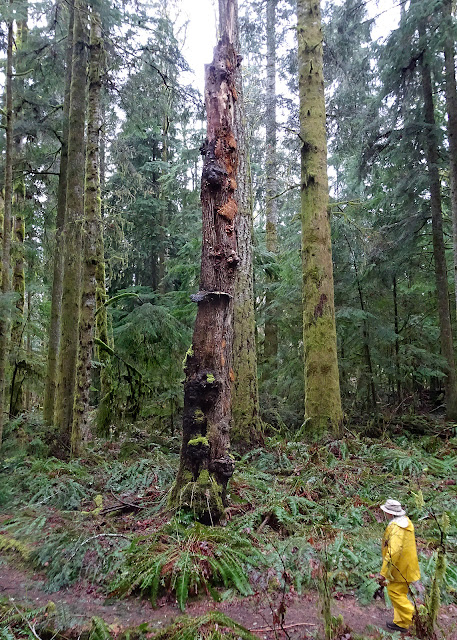 |
| Dead but still standing; a tall stump carries the black shelf fungi that killed it. One of the naturalists on the walk is properly dressed for the weather; Tilley hat and rubber rain gear. |
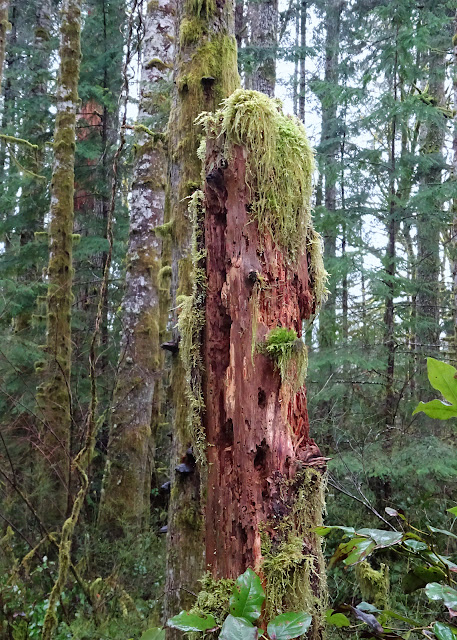 |
| Another stump, well rotted, full of woodpecker holes, with a crown of dangling moss. |
 |
| At least three different mosses here, with last year's maple leaves, and fresh new buds on a twig. |
 |
| Almost looks like electrified cats' tail again. With leaf lichens. |
 |
| Leafy moss with sporophytes. The ripe ones are red; green sporophytes are immature. Raindrops run down some of the stalks. (Aka setae.) |